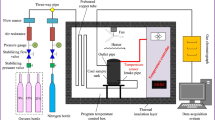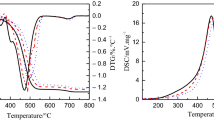Abstract
The conventional Arrhenius equation that estimates the heat generation of coal in numerical simulation has been widely applied. However, the aging effect markedly influences the exothermic behavior of coal at low temperature and cannot be achieved using the conventional Arrhenius equation. In this paper, an improved wire-mesh basket test was performed to measure the temperature and concentrations of CO and CO2 emitted from coal piles. The aging effect model based on the theory of equivalent oxidation exposure time successfully matched the experimental results. Then, a two-dimensional (2D) multifield coupling model of coal stockpiles was developed considering the aging effect to investigate the developments on values and moving paths of temperature and O2 concentration. Effects of decay-power factor, which determines the diminishing coal oxidation, and other main variables on spontaneous combustion of coal stockpiles were systematically investigated. The results indicated a unique critical value of 1.25 × 10–6 s−1 for decay-power factor. Increasing decay-power factor enlarged the safe storage time and hardly affected the moving paths of the hotspot. There are two critical values for particle size (0.7 mm, 9 mm) and porosity (0.18, 0.58), and one critical value for wind velocity (8.5 m s−1) and stockpile width (9 m). Porosity and stockpile width have significant effects on the self-ignition of coal stockpiles when their values are lower than the base ones (0.33 and 15 m). The model considering aging effect is expected to reliably predict the spontaneous combustion of coal stockpile and become the tool for inspecting the reasonability of the relative preventing measures.













Similar content being viewed by others
References
Tang Y, Guo P. Experimental investigation on spontaneous combustion of coal affected by exothermic reaction of polyurethane in underground coal mines. J Therm Anal Calorim. 2022;147(1):337–46. https://doi.org/10.1007/s10973-020-10312-x.
Yuan H, Restuccia F, Richter F, Rein G. A computational model to simulate self-heating ignition across scales, configurations, and coal origins. Fuel. 2019;236:1100–9. https://doi.org/10.1016/j.fuel.2018.09.065.
Zhang H, Zhang X, Wang Y, Wang J, Sasaki K. Study on spontaneous combustion of lignite based on the theory of equivalent oxidation exposure time. J China Coal Soc. 2018;43(5):1358–64. https://doi.org/10.13225/j.cnki.jccs.2017.1170.
Yutao Z, Yuanbo Z, Yaqing L, Xueqiang S, Yujie Z. Heat effects and kinetics of coal spontaneous combustion at various oxygen contents. Energy. 2021;234: 121299. https://doi.org/10.1016/j.energy.2021.121299.
Shi X, Chen X, Zhang Y, Zhang Y, Guo R, Zhao T, et al. Numerical simulation of coal dust self–ignition and combustion under inclination conditions. Energy. 2022;239: 122227. https://doi.org/10.1016/j.energy.2021.122227.
Chen X, Shi X, Zhang Y, Zhang Y, Ma Q. Numerical simulation study on coal spontaneous combustion: effect of porosity distribution. Combust Sci Technol. 2021. https://doi.org/10.1080/00102202.2021.1961760.
Wen H, Yu Z, Deng J, Zhai X. Spontaneous ignition characteristics of coal in a large-scale furnace: an experimental and numerical investigation. Appl Therm Eng. 2017;114:583–92. https://doi.org/10.1016/j.applthermaleng.2016.12.022.
Li Y, Shi X, Zhang Y, Xue J, Chen X, Zhang Y, et al. Numerical investigation on the gas and temperature evolutions during the spontaneous combustion of coal in a large-scale furnace. Fuel. 2021;287: 119557. https://doi.org/10.1016/j.fuel.2020.119557.
Cheng F, Chang Z, Deng J, Nan F, Zhang A, Li B. Numerical evaluation of inclined heat pipes on suppressing spontaneous coal combustion. Heat Mass Transf. 2020;56(6):1861–74. https://doi.org/10.1007/s00231-020-02819-8.
Chu R, Wang M, Meng X, Liu P, Liu Z, Wu J, et al. Numerical simulation and application experiment of the spontaneous combustion tendency of a coal stockpile covered with pulverized coal. Can J Chem Eng. 2020;98(2):616–24. https://doi.org/10.1002/cjce.23643.
Yang S, Zhou B, Wang C. Investigation on coal spontaneous combustion in the gob of Y type ventialtion caving face: a case study. Process Saf Environ Prot. 2021;148:590–603. https://doi.org/10.1016/j.psep.2020.11.024.
Xiao Y, Liu KH, Pang P, Shu CM. Thermokinetics behaviour and parameters for spontaneous combustion of carbonised powders and oxidised powders from preparation of coal-based activated carbon. J Therm Anal Calorim. 2021;144:415–24. https://doi.org/10.1007/s10973-020-10441-3.
Chu T, Li P, Chen Y. Risk assessment of gas control and spontaneous combustion of coal under gas drainage of an upper tunnel. Int J Min Sci Technol. 2019;29(3):491–8. https://doi.org/10.1016/j.ijmst.2018.05.002.
Liu Y, Wen H, Guo J, Jin Y, Wei G, Yang Z. Coal spontaneous combustion and N2 suppression in triple goafs: a numerical simulation and experimental study. Fuel. 2020;271: 117625. https://doi.org/10.1016/j.fuel.2020.117625.
Xu Y, Li Z, Liu H, Zhai X, Li R, Song P, et al. A model for assessing the compound risk represented by spontaneous coal combustion and methane emission in a gob. J Clean Prod. 2020;273: 122925.
Xia W, Yang J, Liang C. Investigation of changes in surface properties of bituminous coal during natural weathering processes by XPS and SEM. Appl Surf Sci. 2014;293:293–8. https://doi.org/10.1016/j.apsusc.2013.12.151.
Tang Y, Zhong X, Li G, Yang Z, Shi G. Simulation of dynamic temperature evolution in an underground coal fire area based on an optimised thermal–hydraulic–chemical model. Combust Theory Model. 2019;23(1):127–46. https://doi.org/10.1080/13647830.2018.1492742.
Zhang L, Qin B, Shi B, Wen K. Formation mechanism of foamed gel for controlling the coal spontaneous combustion. Combust Sci Technol. 2016;188(1):132–43.
Liu X, Guo G, Li H. Study on the propagation law of temperature field in surrounding rock of underground coal gasification (UCG) combustion cavity based on dynamic thermal parameters. Results Phys. 2019;12:1956–63. https://doi.org/10.1016/j.rinp.2019.02.006.
Zhu H, Song Z, Tan B, Hao Y. Numerical investigation and theoretical prediction of self-ignition characteristics of coarse coal stockpiles. J Loss Prev Process Ind. 2013;26(1):236–44. https://doi.org/10.1016/j.jlp.2012.11.006.
Zhang J, Liang Y, Ren T, Wang Z, Wang G. Transient CFD modelling of low-temperature spontaneous heating behaviour in multiple coal stockpiles with wind forced convection. Fuel Process Technol. 2016;149:55–74. https://doi.org/10.1016/j.fuproc.2016.04.011.
Zheng H, Wang J, Yu Q. Simulation of spontaneous combustion region in coal piles under multi-field coupling. Int J Coal Prep Util. 2021;41(12):855–67. https://doi.org/10.1080/19392699.2018.1538976.
Kim CJ, Sohn CH. Effects of wind barrier design and closed coal storage on spontaneous ignition of coal stockpiles. J Loss Prev Process Ind. 2016;40:529–36. https://doi.org/10.1016/j.fuel.2016.02.059.
Qu G, Li H, Jia T, Wang L. Experimental and numerical simulation and study of spontaneous combustion characteristic of coal piles. China Saf Sci J. 2021;31(12):69–77. https://doi.org/10.16265/j.cnki.issn1003-3033.2021.12.010.
Zhang Y, Wang J, Xue S, Wu J, Chang L, Li Z. Kinetic study on changes in methyl and methylene groups during low-temperature oxidation of coal via in-situ FTIR. Int J Coal Geol. 2016;154–155:155–64. https://doi.org/10.1016/j.coal.2016.01.002.
Thabari JA, Supit S, Nirbito W, Muharam Y, Nugroho YS. Modeling on the effect of heat exchanger submersion on controlling spontaneous combustion in a coal pile. J Adv Res Fluid Mech Therm Sci. 2021;81(1):158–64.
Zhang J, Choi W, Ito T, Takahashi K, Fujita M. Modelling and parametric investigations on spontaneous heating in coal pile. Fuel. 2016;176:181–9. https://doi.org/10.1016/j.fuel.2016.02.059.
Arisoy A, Beamish B. Reaction kinetics of coal oxidation at low temperatures. Fuel. 2015;159:412–7. https://doi.org/10.1016/j.fuel.2015.06.054.
Yuan L, Smith AC. CFD modeling of spontaneous heating in a large-scale coal chamber. J Loss Prev Process Ind. 2009;22(4):426–33. https://doi.org/10.1016/j.jlp.2009.02.016.
Miura K, Ohgaki H, Sato N, Matsumoto M. Formulation of the heat generation rate of low-temperature oxidation of coal by measuring heat flow and weight change at constant temperatures using thermogravimetry-differential scanning calorimetry. Energy Fuels. 2017;31(11):11669–80. https://doi.org/10.1021/acs.energyfuels.7b01817.
Baris K, Kizgut S, Didari V. Low-temperature oxidation of some Turkish coals. Fuel. 2012;93:423–32. https://doi.org/10.1016/j.fuel.2011.08.066.
Song JJ, Deng J, Zhao JY, Zhang YN, Shu CM. Comparative analysis of exothermic behaviour of fresh and weathered coal during low-temperature oxidation. Fuel. 2021;289: 119942. https://doi.org/10.1016/j.fuel.2020.119942.
Zhang J, An J, Wang Y, Al Mamun NA, Pan R. Philosophy of longwall goaf inertisation for coal self-heating control, proactive or reactive? Int J Heat Mass Transf. 2019;141:542–53. https://doi.org/10.1016/j.ijheatmasstransfer.2019.07.004.
Zhang J, Ren T, Liang Y, Wang Z. A review on numerical solutions to self-heating of coal stockpile: mechanism, theoretical basis, and variable study. Fuel. 2016;182:80–109. https://doi.org/10.1016/j.fuel.2016.05.087.
Zarrouk SJ, O’Sullivan MJ. Self-heating of coal: the diminishing reaction rate. Chem Eng J. 2006;119(2–3):83–92. https://doi.org/10.1016/j.cej.2006.03.007.
Tomaszewicz M, Łabojko G, Tomaszewicz G, Kotyczka-Morańska M. The kinetics of CO2 gasification of coal chars. J Therm Anal Calorim. 2013;113(3):1327–35. https://doi.org/10.1007/s10973-013-2961-2.
Zhang H, Sasaki K, Zhang X, Sugai Y, Wang Y. Numerical simulations on the self-heating behaviours of coal piles considering aging effect. Combust Theory Model. 2019;23(6):1169–90. https://doi.org/10.1080/13647830.2019.1644378.
Wang H, Dlugogorski BZ, Kennedy EM. Oxygen consumption by a bituminous coal: time dependence of the rate of oxygen consumption. Combust Sci Technol. 2002;174(9):165–85. https://doi.org/10.1080/713713083.
Sasaki K, Miyakoshi H, Otsuka K. Spontaneous combustion of coal in the low temperature range-application of exposure equivalent-time to numerical analysis. J Min Metall Inst Jpn. 1987;103(11):771–5. https://doi.org/10.2473/shigentosozai1953.103.1197_771.
Kaji R, Hishinuma Y, Nakamura Y. Low temperature oxidation of coals-a calorimetric study. Fuel. 1987;66(2):154–7. https://doi.org/10.1016/0016-2361(87)90233-X.
El Mejdoub N, Delfosse L. Elovichian kinetics during chemisorption of oxygen on semicoke. Combust Flame. 1989;77(1):31–9. https://doi.org/10.1016/0010-2180(89)90102-8.
Zhang Y, Wu J, Chang L, Wang J, Li Z. Changes in the reaction regime during low-temperature oxidation of coal in confined spaces. J Loss Prev Process Ind. 2013;26(6):1221–9. https://doi.org/10.1016/j.jlp.2013.05.008.
Restuccia F, Fernandez-Anez N, Rein G. Experimental measurement of particle size effects on the self-heating ignition of biomass piles: homogeneous samples of dust and pellets. Fuel. 2019;256: 115838. https://doi.org/10.1016/j.fuel.2019.115838.
Taraba B, Michalec Z, Michalcová V, Blejchař T, Bojko M, Kozubková M. CFD simulations of the effect of wind on the spontaneous heating of coal stockpiles. Fuel. 2014;118:107–12. https://doi.org/10.1016/j.fuel.2013.10.064.
Wu D, Norman F, Schmidt M, Vanierschot M, Verplaetsen F, Berghmans J, et al. Numerical investigation on the self-ignition behaviour of coal dust accumulations: The roles of oxygen, diluent gas and dust volume. Fuel. 2017;188:500–10. https://doi.org/10.1016/j.fuel.2016.10.063.
Hooman K, Maas U. Theoretical analysis of coal stockpile self-heating. Fire Saf J. 2014;67:107–12. https://doi.org/10.1016/j.firesaf.2014.05.011.
Ejlali A, Mee DJ, Hooman K, Beamish BB. Numerical modelling of the self-heating process of a wet porous medium. Int J Heat Mass Transf. 2011;54(25–26):5200–6. https://doi.org/10.1016/j.ijheatmasstransfer.2011.08.025.
Akgün F, Essenhigh RH. Self-ignition characteristics of coal stockpiles: theoretical prediction from a two-dimensional unsteady-state model. Fuel. 2001;80(3):409–15. https://doi.org/10.1016/S0016-2361(00)00097-1.
Acknowledgements
This work was supported by JSPS KAKENHI (Grant numbers [20K21163] and [20H02684])
Author information
Authors and Affiliations
Corresponding author
Ethics declarations
Competing interests
The authors have no competing interests to declare that are relevant to the content of this article.
Additional information
Publisher's Note
Springer Nature remains neutral with regard to jurisdictional claims in published maps and institutional affiliations.
Rights and permissions
Springer Nature or its licensor (e.g. a society or other partner) holds exclusive rights to this article under a publishing agreement with the author(s) or other rightsholder(s); author self-archiving of the accepted manuscript version of this article is solely governed by the terms of such publishing agreement and applicable law.
About this article
Cite this article
Zhang, H., Zhang, X., Wang, Y. et al. Application of aging effect model in numerical simulation for predicting spontaneous combustion of coal stockpiles. J Therm Anal Calorim 147, 13847–13860 (2022). https://doi.org/10.1007/s10973-022-11708-7
Received:
Accepted:
Published:
Issue Date:
DOI: https://doi.org/10.1007/s10973-022-11708-7




